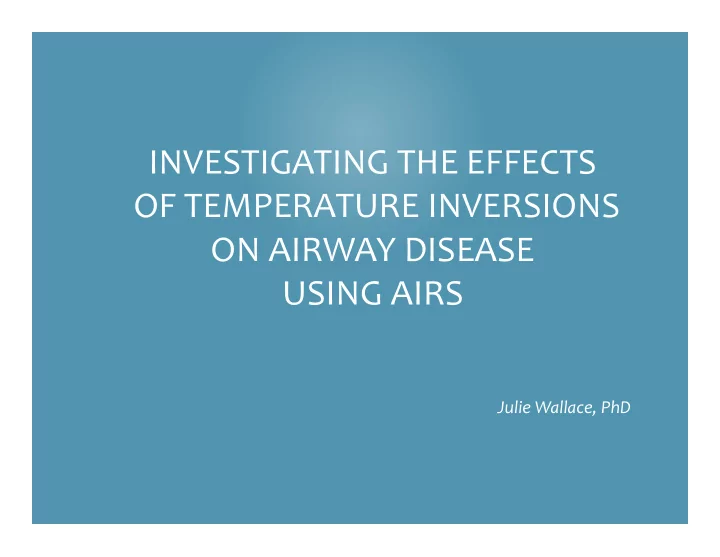

INVESTIGATING THE EFFECTS OF TEMPERATURE INVERSIONS ON AIRWAY DISEASE USING AIRS Julie Wallace, PhD
BACKGROUND L. Ontario Hamilton L. Erie • Previous study on bronchitis and proximity to roads • Separate study on effect of temperature inversions on air pollution
FIRESTONE INSTITUTE Juravinski Innovation OF RESPIRATORY Tower HEALTH • Bronchitis quantitatively defined by proportion of various types of white blood cells • Sputum samples from patients • Cell counts – Type of airway disease (bronchitis) – Severity of airway disease
CELL TYPES • Neutrophils and Macrophages • White blood cells • First line of defense against infection • Respond quickly It takes two to tango: cigare0e smoke partners with viruses to promote emphysema , Rubin M. Tuder, Jeong H. Yun, J. Clin. Invest. 2008; 118 (8):2689
STUDIES • A few studies suggesting that air pollution caused an increase in neutrophil cells in the airways – Nobutomo, K., 1978. Air pollution and cytological changes in sputum. Lancet 1: 523‐526. – Dragonieri, S., Musti, M., Izzo, C., Esposito, L.M., Barbaro, M.P.F., Resta, O., Spanevello, A., 2006. Sputum induced cellularity in a group of traffic policemen. Sci Total Environ 367: 433‐436. – Wardlaw, A.J., Silverman, M., Siva, R., Pavrod, I.D., Green, R., 2005. Multi‐dimensional phenotyping: toward a new taxonomy for airway disease. Clinical and Experimental Allergy 35: 1254:1262. – Bosson, J., Pourazar, J., Forsberg, B., Adelroth, E., Sandström, T., Blomberg, A., 2008. Diesel exhaust exposure enhances the ozone‐ induced airway inflammation in healthy humans. Eur Respir J 31: 1234‐1240.
TEMPERATURE INVERSIONS • Influenced by Niagara Escarpment Niagara Escarpment • Proximity to Great Lakes L. Ontario L. Erie Source: Google Maps
TEMPERATURE INVERSIONS JUNE 2009
STS092 October 21, 2000 HAZE OVER LAKE ERIE NO2 (ppb) 20 30 40 25 35 45 10 15 0 5 10/7/2000 10/8/2000 10/9/2000 10/10/2000 October 7 – 31, 2000 NO 2 (ppb) 10/11/2000 10/12/2000 10/13/2000 10/14/2000 10/15/2000 10/16/2000 10/17/2000 10/18/2000 10/19/2000 10/20/2000 10/21/2000 10/21/2000 10/22/2000 10/23/2000 10/24/2000 10/25/2000 10/26/2000 10/27/2000 10/28/2000 10/29/2000 10/30/2000 10/31/2000
AIRS TEMPERATURE PROFILES • Data from GIOVANNI • AIRS Level 3, version 5 , • AM/PM temperature profiles • 2004‐2006
PATIENT LOCATIONS
CELL COUNTS - STABLE GROUP • Neutrophil % increased • Consistent with other studies • Largest increases in asthma patients
EXACERBATED GROUP • Macrophages increased on inversion days • COPD patients • Different mechanism in the response to air pollution?
MULTIVARIATE STATISTICAL ANALYSES • Controlling for – Smoking – Age – Medication – Temperature and humidity • Daytime and night‐time inversions
MULTIVARIATE RESULTS STABLE EXACERBATED Dependent Variable Neutrophils (%) Macrophages (%) Continuous Independent variables IQR change in percent IQR change in percent macrophage neutrophil (95%CI) (95%CI) Age (years) 21.1(16.8,25.5) -1.6(-2.2,-1.2) Temperature o C -0.9(-5.3,3.5) -1.2(-1.6,1.1) Relative humidity % -2.3(-6.4,1.8) -1.2(-1.5,1.2) Inhaled corticosteroids ( µ g/day) 1.0(-2.0,4.0) 0(0,0) Categorical Independent Variables Change in percent Change in percent neutrophil macrophage (95%CI) (95%CI) -1.0(-7.0,4.9) 1.7(1.1,2.7) Smoker versus non-smoker Same day inversion versus 12.6 (3.9,21.4) 2.5 (1.3,4.8) normal day (AIRS)
CONCLUSIONS • Cellular response to temperature inversions identified – Increased air pollution – Increased allergens – Combination • Mechanism may be different for patients who are stable and exacerbated • Response occurs in short‐term (within hours) • Interesting – the associations of spatial scales from regional/ global to cellular
IMPLICATIONS • Current environmental conditions not previously considered • Could not always explain increases in cell counts in stable patients • Re‐think patient diagnoses • Occurrence of temperature inversions should be added to air quality forecasts and Air Quality Health Indices
Recommend
More recommend